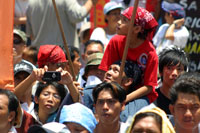Thursday, April 25, 2024
News and Views from the Global South
MEDIA: Mobile Journalism on the Rise in Asia
Kara Santos
- What do the protests in Burma, bombings in Jakarta, the recent earthquake in Haiti and the massive devastation left by typhoon Ketsana in the Philippines have in common?

Mobile phones are increasingly becoming an important newsgathering tool in Asia. Credit: Kara Santos/IPS
In the Philippines, graphic images taken with mobile phones of the extent of destruction wrought by the September 2009 disaster on hundreds of thousands of affected residents conveyed to the world the depth of the ensuing tragedy.
In Burma, the use of mobile phones to relay crucial information to the public as well as to the outside world has proved “very handy,” Mon Mon Myat, a stringer for Agence France Presse in Burma (officially called Myanmar), where media are under strict censorship, told IPS.
“It’s very safe to shoot using a mobile phone because people think you’re just taking photos and not video. It’s less risky for us,” said the Burmese journalist, adding that they could easily hide or dispose of the phone if needed.
Media experts say that mobile phones are increasingly becoming an important newsgathering tool in Asia. Mobile news coverage is said to be used by major broadcast networks like Al Jazeera. This phenomenon has given rise to ‘mobile journalism’, otherwise known as ‘mojo’.
The concept of mobile journalism refers to the use of information and communication technologies, including mobile phones, to post stories, images and videos on the web within seconds of their composition.
This type of newsgathering is especially relevant for breaking news events and countries with strictly controlled media.
According to the book ‘Mojo – Mobile Journalism in the Asian Region’ authored by Dr Stephen Quinn, a journalism professor at Deakin University in Australia, as of mid-2009, more than 4.2 billion mobile phones were being used around the world, with 43 percent of mobile phone usage from the Asian region.
The International Telecommunications Union says that the mobile phone is the fastest-growing communication device in history, with the percentage of users in the developed world jumping from 18 percent in 1997 to 97 percent in 2007.
Because mobile phones are so common in developing countries, it is easy for mobile journalists to blend in a crowd. In the Philippines, for instance, mobile phones are commonly used to capture images and footage of disaster and conflict situations.
“Photographers are at the front line. They need to be in a place where the news is happening, and sometimes using mobile phones is the best way to capture an image, especially if access is limited,” photojournalist and founding member of the Philippine Center for Photojournalism Jimmy Domingo told IPS.
Photographers and video journalists who have to transmit files to their newsrooms fast find that innovations in mobile cameras make their job easier. Gadgets like the Flip video camcorders allow users to take video and transfer files easily to a computer or post video to the web. The Flip Mino, a compact model weighing less than 150 grams can shoot high-definition videos.
Apple Inc.’s popular iPhone also has new reporting applications that can transform it into a radio reporting device or multimedia, broadcast and podcast tool.
Poddio, designed for radio broadcasters, allows users to record, edit, and send complete radio news packages via the iPhone faster than sending via a laptop.
Given all these technological advances, research firm Datamonitor predicts that mobile phone usage in the Asia-Pacific region will jump from 389 million in 2007 to 890 million by 2012.
Speaking at a recent media forum in Manila, Dr Quinn said these advances would make news delivery even faster. “With the technological capabilities of modern gadgets, ‘mojos’ or ‘mobile journalists’ can easily put together a story in the field, edit and transmit it to the web, moments after an event takes place,” he said.
Unlike one person carrying a mobile phone, a typical video crew requires equipment like a camera, tripod, laptop and cables to work. “Tools need to be easy to use so they don’t get in the way of telling a story,” said Quinn.
Still and all, experts agree that going back to the basics remains fundamental.
“It’s not possible to do new media until you do old media properly,” said Quinn, adding that a solid grounding on journalism, research and writing skills, and knowledge of ethics is vital for journalists.
Photojournalist Domingo agrees that photographers should first know how to use standard cameras for coverage and use mobile phones only when the situation calls for it.
“If an event happened in a place where only mobile phones are available, the more important thing is to be able to bring the photograph out into the news and tell the story,” he said.

 Print
Print



